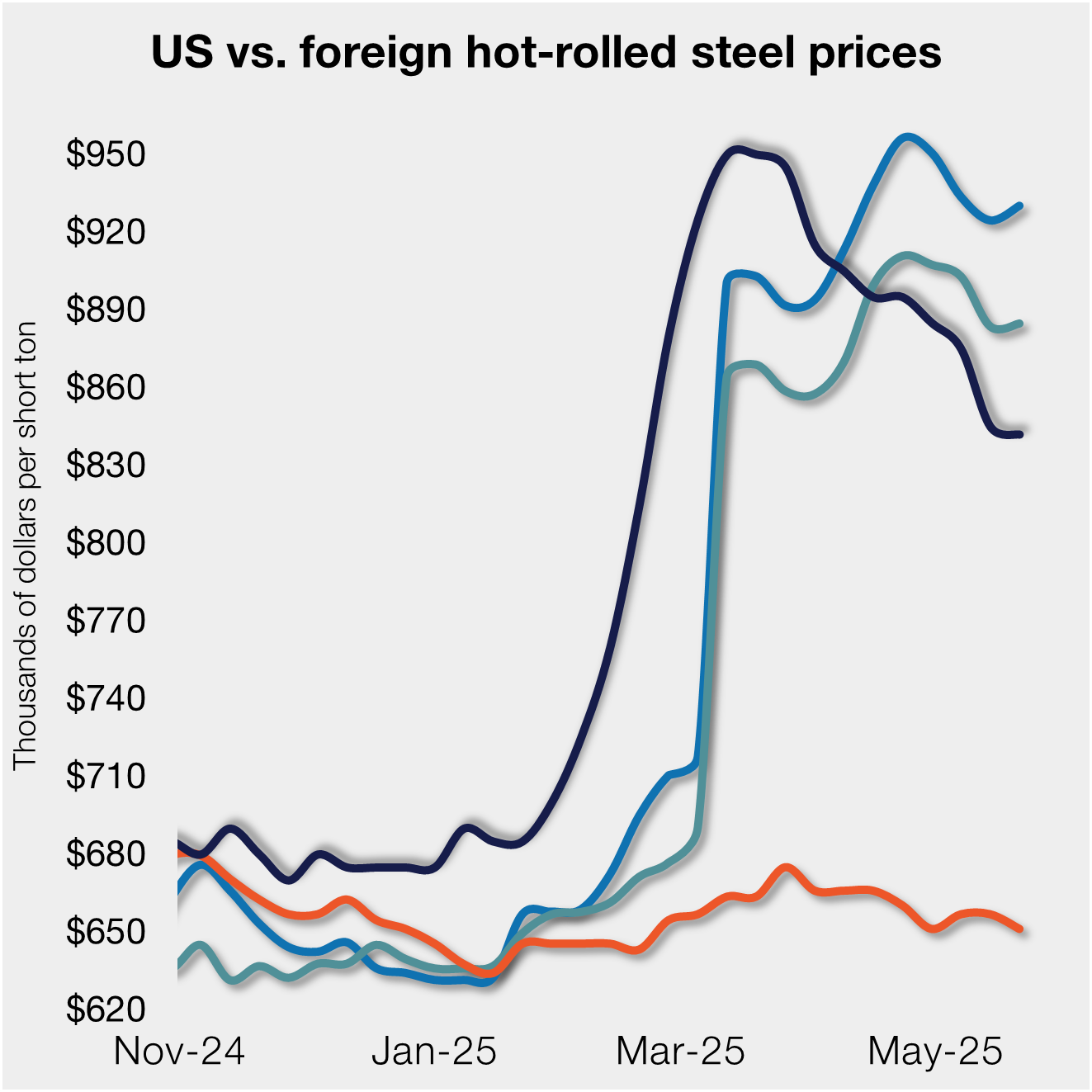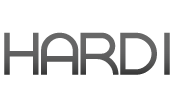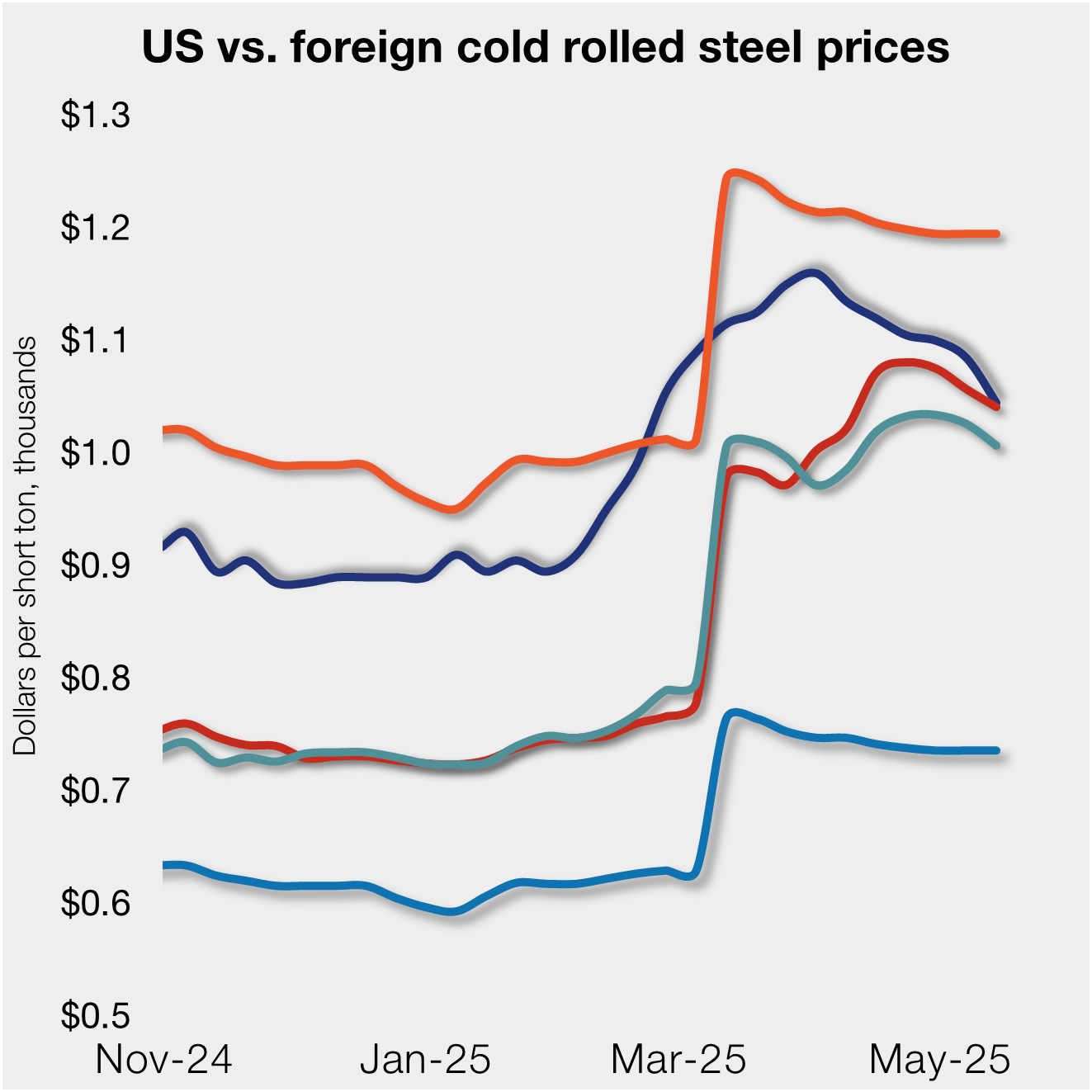Steel Products

Another Round of Steel Price Increases Coming?
Written by John Packard
May 10, 2020
If there is one thing you can count on with the steel industry, it’s for rumors to begin flying as soon as the mills appear to have seized pricing momentum. The domestic steel mills, led by ArcelorMittal USA, began announcing price increases the week ending May 1. The announcements ranged from $50 to $60 per ton ($2.50/cwt-$3.00/cwt) with two mills opting to provide specific base prices: ArcelorMittal with hot rolled at $500 and cold rolled/coated at $700 per ton, and NLMK USA $20 higher at $520 and $720 per ton (note: the NLMK Portage mill is not taking any orders for June due to planned maintenance).
It is not unusual for the domestic mills to “cement” in the first round of price increases by announcing further bumps in the minimum base price. Whether the new round will be to take prices above $520 per ton, or to achieve and firm the $500 per ton number, will only be known as steel buyers react to any new price announcements.
Right now, the second round of price announcements has not happened, but the debate about the justification for a new round is ongoing.
![]() Prior to the announcements, astute steel buyers had been picking up hot rolled with base prices in the very low $400s and cold rolled and coated base prices in the very low $600s (lower if you factor in adjustments on some of the extras).
Prior to the announcements, astute steel buyers had been picking up hot rolled with base prices in the very low $400s and cold rolled and coated base prices in the very low $600s (lower if you factor in adjustments on some of the extras).
Those deals quickly evaporated (after the normal one to three days of mills allowing their regular customers to send in orders at prices quoted prior to the announcements), and the lower end of the range rose by $20 to $60 per ton to $460-$500 per ton.
Late last week steel buyers were informing Steel Market Update that the mills were consistently quoting $480-$500 per ton with a couple of outliers above $500 on benchmark hot rolled.
By late last week ferrous scrap prices for the month of May rose by $30 to $50 per gross ton. A $20 to $30 per ton bump in scrap was expected. Prime grades at up $50 puts a squeeze on mill margins. As one mill executive put it to SMU late last week, “Busheling at $310 sure makes you regret hot rolled booked at $420-$440.”
The rumors were in circulation on Friday when SMU was advised (asked?) to see if one of the “major” flat rolled mills was pondering raising prices again.
We were reminded that Nucor has a new CEO at the helm, and with the retirement of Ladd Hall as the Vice President of Flat Rolled the market was not quite sure how the new management team would react to higher scrap prices with the appearance of pricing momentum being on their side.
{loadposition reserved_message}
We reached out to a select group of steel buyers to gather their opinions as to whether the market could support another price increase based on their perspectives regarding supply and demand.
A national service center told SMU they believe flat rolled prices could go higher from here because “there should be additional upside available for three reasons: mills have chopped capacity significantly, cost of scrap is increasing due to low inventories and higher demand, and automotive is coming back online shortly. I think that the re-opening of automotive has the potential to create a more dramatic impact in the short run on both steel supply and prices. By the time integrated mills decide to re-start blast furnaces, we’ll likely be going through some level of extended lead-times and higher prices. Otherwise, they won’t need to add back production without that occurring first.”
A manufacturing company provided an opposing opinion: “I’m not hearing many buyers [paying] the latest increase, much less stomaching another one. I just don’t understand a potential additional round of increases. Another round of increases will push me to hit send on the import orders I have been contemplating, as I see CR below $30/cwt landed Houston loaded truck, and base galvanized below $31/cwt Houston loaded truck. I’m already buying more from Mexico in HR/CR/GALV than I did in 2019. I talked to a few others this week that are buyers and they feel the same way; back to Imports we go. Domestic mills just can’t learn their lesson. I understand capacity has been taken offline, however demand has to return and that will take the rest of the year to get back to 2019 levels–maybe even 2021 before that happens.”
A Midwest service center told SMU, “There is not enough demand for another price increase to stick.”
Another Midwest service center told us they doubt the domestic mills will collect all of the first price increase. “We don’t think so. I think the mills can collect a portion of the increase, but I do not think demand is there to collect all at this time.” When asked to comment about the potential of a second round of increases, SMU was told, “We think it’s doubtful. A second increase could be an attempt to shore up the first increase. Pricing has gotten very low – relative to scrap of course. So, an increase of some degree certainly makes sense to aim for. But at this time, we feel that true end-demand is still ways off and further increase efforts will not likely move the needle much. We feel pricing can move when end-demand starts to recover in a meaningful way. While most of our customers are operational, nearly all have lower demand forecasts for the near-term.”
A southern-based service center echoed comments that the steel mills are not yet collecting all of the first price increase. “The mills are not collecting the full increase, although it did stop the spread. As always, though, it depends on what you were paying. Certainly, the first increase did take pricing up somewhat.” Commenting on the possibility of a second round of increases, this head of purchasing said: “No, there is no room yet for another, and it is an unfortunately typical mill move to just push pricing up out of sheer will. The first increase was necessary and timely as the market adjusted to the new norm, capacity came out, and inventory levels were low. Mills definitely felt higher ‘apparent’ demand. However, overall consumption is not up dramatically and does not warrant additional increases. If the mills would settle in, collect this increase and let the market gain some confidence, the HRC market would be more stable going into summer. Another increase will cause hesitation throughout the supply chain – who feels good buying a bunch of steel right now? They aren’t going to be able to push customers into buying – no one knows what demand holds.”
One buyer told SMU to watch scrap pricing for the month in June. If scrap looks like it will rise again next month, then expect a price increase announcement toward the end of May.
The next couple of weeks will prove to be another in a long line of interesting weeks in the steel industry.

John Packard
Read more from John PackardLatest in Steel Products

Nucor maintains plate prices, again
Nucor aims to keep plate prices flat again with the opening of its July order book.

Asian HR remains much cheaper than US, EU product
Domestic hot-rolled (HR) coil prices were flat this week after declining seven of the last nine weeks. Offshore prices have also eroded in recent weeks, though not nearly as significantly as in the US.

Galv buyers less optimistic about short-term market
“It was a little more of a seller's market as contractors seemed to be protecting themselves against a potential run up in prices," one buyer said.

SMU flat-rolled market survey results now available
SMU’s latest steel buyers market survey results are now available on our website to all premium members. After logging in at steelmarketupdate.com, visit the pricing and analysis tab and look under the “survey results” section for “latest survey results.” Past survey results are also available under that selection. If you need help accessing the survey results, or if […]

US, offshore CRC prices continue to fall
US cold-rolled (CR) coil prices were down again this week, slipping six weeks in a row and seeing the sharpest drop-off since last July.
